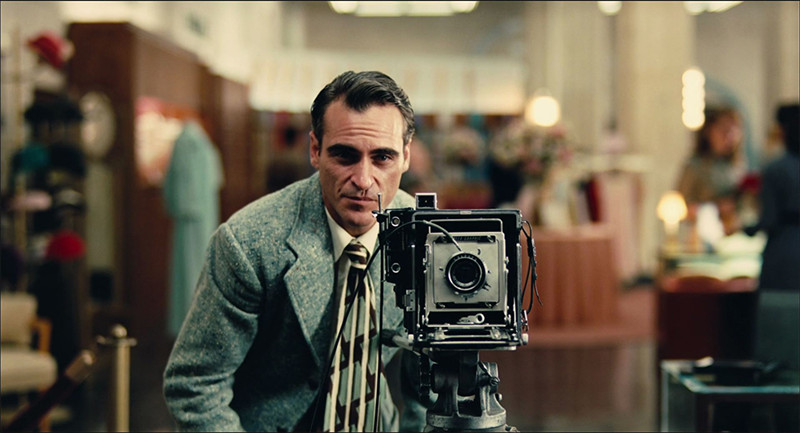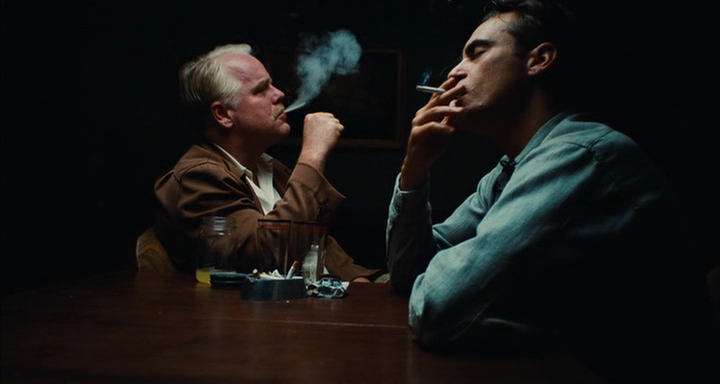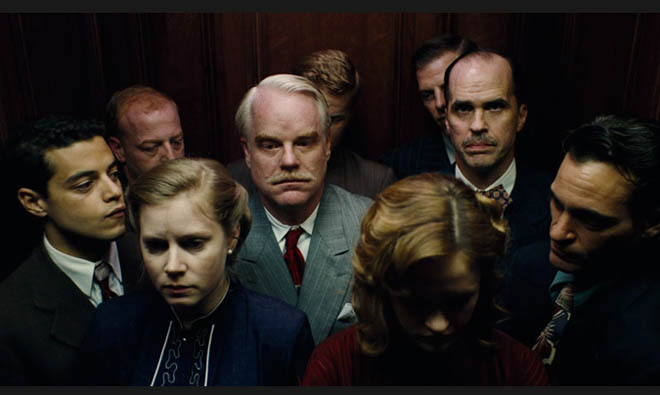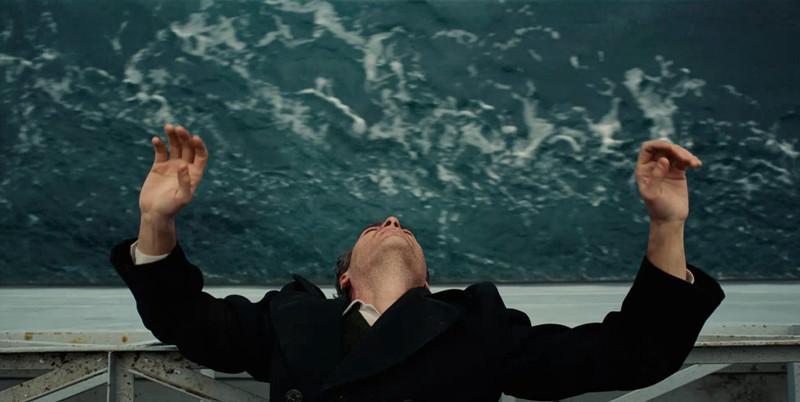
Paul Thomas Anderson’s The Master is one of the finest works of our time. The incredible artistic merit of the work is rarely disputed; it ranked 24 on the BBC’s 2016 poll of the best films of the 21st century, which polled 177 renowned critics worldwide, and it received almost unanimous praise upon its release.
However, in the context of PTA’s filmography, The Master is tragically often overshadowed by films like Boogie Nights, which put Anderson on the map, Magnolia, which he famously referred to as the best film he’ll ever make, and 2007’s There Will Be Blood, a gritty drilling into Gilded Age America loosely based on Upton Sinclair’s novel Oil!
While the three aforementioned films are incredible in their own right, they tend to hog the PTA spotlight – in the yearly updated “1001 Movies You Must See Before You Die,” these three films have been included in almost every publication, while The Master has yet to be mentioned.
The Master follows Freddy (played to perfection by Joaquin Phoenix), a World War II Veteran trapped in a state of loneliness, guilt, indecisiveness, and seeking. He struggles to make sense of things in a wonderfully and accurately captured 1950s America, constantly finding himself indulging in vices and kerfuffles that remedy his conveniently ignored and stigmatized PTSD.
On the run after accidentally killing a man with a grotesque, moonshine-paint-fluid mysterious cocktail Freddy has been serving to people in search of something new, his path aligns with a cult movement known as ‘The Cause’, heralded by a charismatic Lancaster Dodd (Phillip Seymour Hoffman in one of his career bests). Freddy joins the movement, at first to prepare this illusive, symbolic mix for Dodd, but eventually as a fully immersed follower.
The Master is Paul Thomas Anderson’s most underrated masterpiece, no pun intended – not because it isn’t well received, but only because it is overshadowed by Anderson’s better-known work. As a matter of fact, his 2012 psychological drama may well be his best film to date. Here are some reasons why.
1. Rich, Teleological Cinematography

The Master stands out for its innovative cinematography, some of the best of its time. The first American film shot on 65mm since 1996, the entire work has a crispness to it that can’t be matched. The selected film stock elevates The Master’s ability to capture Post World War II America – the visual aesthetic evokes a nauseating combination of nostalgia, trauma, and everything in between.
As recently as 2015, Quentin Tarantino shot his eighth (and worst) film The Hateful Eight on 70mm with hopes of restoring appreciation of the practically dead and drastically expensive medium. The use of extremely gigantic film stock failed to really add anything to his rushed, post-civil war quasi-western.
Where Tarantino failed, Anderson succeeded. The Master is the singlehanded best item of evidence in the world for why 21st century filmmakers should continue to use ultra-wide film stock if it’s an option and complements their work well. All of the camerawork seems to be in a state of purgatory, a perfect choice to capture the Post WWII American Collective Psyche (more on that later).
The merit of Mihai Malaimare’s cinematography extends beyond its materials – every shot in the film makes wonderful use of light and color, and not a single shot seems wasted. The dramatic contrasting blues and whites of the ocean, a recurring motif in the film, generate ominous currents – there’s just something about the way Malaimare captures it.
A scene where Joaquin Phoenix’s Freddy serves his gross cocktail to a hooker, illuminated by grotesque dark green light, comes to mind for its determined use of every available tool in and outside the frame. After a failed attempt to let The Cause’s bug bite an upper class party in New York City, Dodd’s gang crowds into an elevator lit by a dramatic beam of light like a Caravaggio painting, the camera angled from above, wonderfully capturing emotions of claustrophobic mood swinging escapade.
Everything about every shot in this film leaves a lasting impression and feels imbued with purpose and insight. While it failed to even clinch an Oscar nomination, Malaimare’s cinematography is some of 2012’s finest work.
2. An Incredible Cast

The thespian accomplishment of There Will Be Blood stands out as some of the finest acting of all time. Daniel Day-Lewis’s transformation into Daniel Plainview is unforgettable, and Paul Dano’s supporting performance as the Sunday twins proves him a worthy opponent.
But Anderson’s ability to direct actors and produce their finest work is evident throughout his filmography – hell, the guy brought out something tender, sensitive, and raw from Adam Sandler! The Master has a strong ensemble of talented players, each delivering some career best work.
Joaquin Phoenix’s turn as Freddy, which earned him an Oscar nomination for best actor in a leading role (Hoffman and Adams were nominated in the supporting actor categories as well), is gentle yet aggressive, masculine yet castrated, innocent yet ruined, honest yet duplicitous. He jams together otherwise mutually exclusive traits, perfectly capturing the essence of unprecedented trauma. He avoids borrowing from typical ideas of PTSD and breathes new life into the role of the war-vet, delivering a landmark performance that stands out on its own.
Freddy is matched by the charismatic, narcissistic, at times forgivable, Elron Hubbard inspired, Lancaster Dodd, the last truly great role played by Phillip Seymour Hoffman. Hoffman, a master of conveying stacked layers of secretive emotions and intentions, lends agency to this role, perhaps taking a bow for all the incredible magic he cooked up with Anderson for almost two decades. What better a way to go out then with a performance that borders on grandiose and subtlety, rich with philosophical commentary, critique and empathy for the evil of Scientology.
The two leading men are surrounded by a top-notch group of actors, including Amy Addams as Dodd’s most recent wife, smiley, loyal, and under his spell; a young Rami Malek as his son in law, eager to rush to his defense; and the always wonderful Laura Dern as a Cause-sympathizer who provides housing for the band of dogmatists.
While a talented cast delivering some of their best performances seems synonymous with Paul Thomas Anderson at this point, The Master’s thespians work their hardest to spellbind.
3. An Insightful, Unique Look At America, Post WWII

The Master deserves as much praise as a film can receive for its exploration of 1950s America and the Post World War II collective American psyche. Not only does it reject the proud, certain-of-self American-ness that so well masked a society in pain, it gives that façade an icepick lobotomy, exploiting the unspoken desires, questions, fantasies and realities of a country returning from a war of such massive and unprecedented scale. The Master argues that World War II didn’t end in the Pacific; it came home with our troops.
The film’s opening sequence shows Freddy and his fellow War Vets in all their madness and animosity, taking turns fucking a ‘woman’ made of sand on a hot Guadalcanal beach. The eccentric, bipolar tone set by the few minutes of ‘war’ scenes that open the film (which don’t include any actual battles, another rejection of tradition) carries its way throughout the film, from the most peaceful to most violent scenes.
The Master is plenty aware of the image of 1950’s America it so boldly contradicts – some of the film’s most jarring points occur with a perfectionist, simple, symmetrical landscape in the background – Freddy initially takes a job as a photographer, surrounded by scenes of crispness, harmless cigarette smoke, and tranquil jazz music. People throughout the film are dressed appropriately and carry themselves in robotic uniformity. Anderson brilliantly uses the cult of 1950s American society to hold up a mirror to the origins of our now most infamous cult, leaving America culpable.
In the strangest ways, The Master is an American Dream movie – or a nightmare. Freddy’s unanchored attempts to find purpose and calm in a bed of scaring memories (which he’s not really allowed to speak about) leave The Cause as a sort of euthanasia, spinning the notion of coming to America to make a better life for one’s self.
Although Dodd’s quest is almost certainly to create a cash vacuum, His Teddy-Roosevelt-like charm makes his intentions almost always seem pure, and the Cause is just an avenue to plant one’s seed. This cult becomes one with a soldier’s homecoming, and blends into a larger American tapestry.